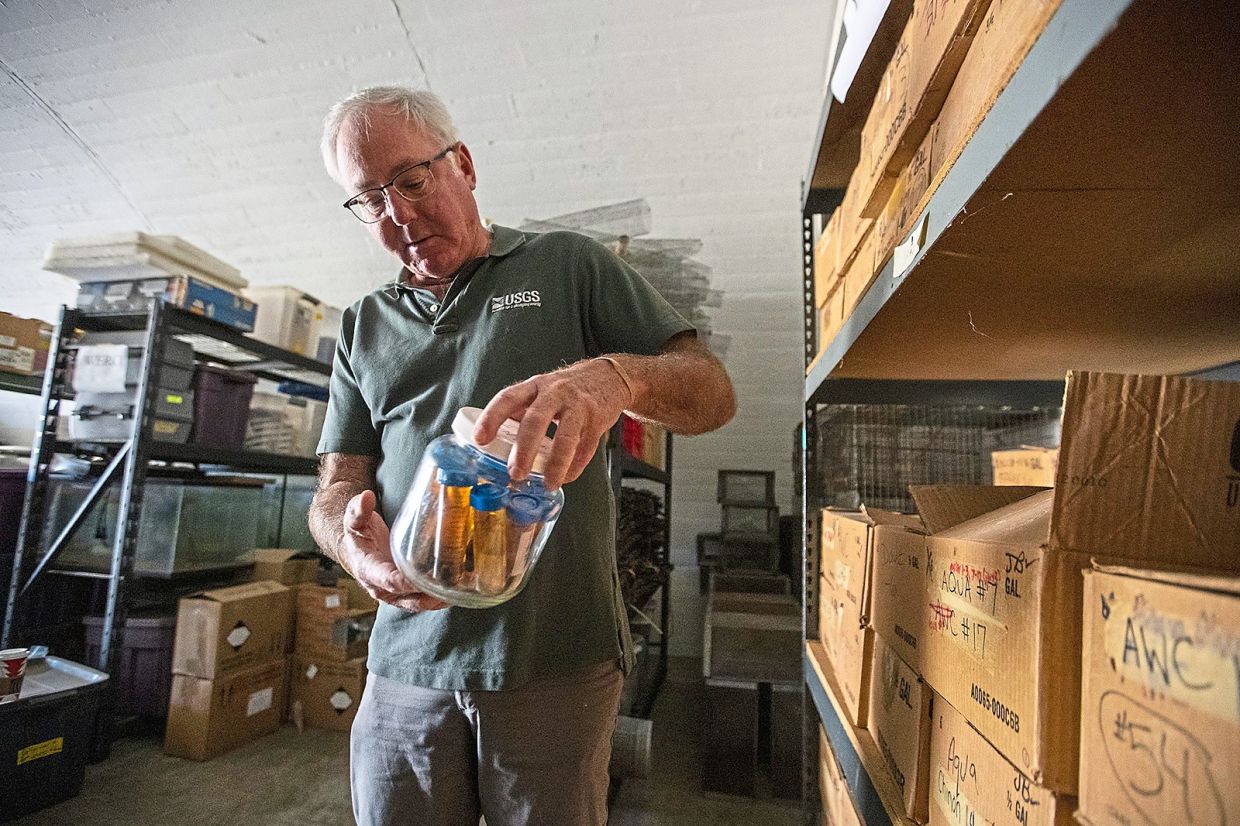Jared Heath opening the massive steel doors of a former WWII munitions bunker at the decommissioned El Toro Marine Corp Air Station on Dec 14, 2022, in Irvine, California. The bunker is used to store an important collection of invertebrates. — Photos: TNS
A World War II-era weapons bunker in Irvine, California, has a new mission – sheltering preserved insect specimens.
When a collection of bugs floating in specimen bottles outgrew his laboratory, Robert Fisher moved them into an abandoned weapons bunker at the former El Toro Marine Corps Air Station in Irvine.
Now, the fortification protects 6,000 invertebrates suspended in ethanol alcohol. Fisher, a research biologist with the US Geological Survey (USGS), began collecting the specimens 25 years ago, when far fewer wild populations in California were in danger of extinction.
“For years, I couldn’t find anybody who cared about this stuff,” Fisher said with obvious pleasure as he led a group of visitors into the bunker recently. “That was before DNA barcoding became a popular research technique.”
Advances in DNA barcoding have made all those soggy centipedes, millipedes, snails, spiders, weevils, earwigs, bees, flies, wasps, beetles and ants very valuable for much more than what meets the eye.
Testing just a drop of ethanol can reveal bits of genetic data from other organisms that shared the landscape with the specimen when it was alive: Fungi, bacteria, mites, even the parasites in its gut. It could also detect all that remains of species that no longer exist.
Scientists say that amid global warming and rapid die-offs of species, such genetic findings are vital in protecting biodiversity and improving ecosystem management.
The search for clues has spawned a new field that Scott E. Miller, chief scientist of the Smithsonian Institution, calls “museomics”: Determining the DNA in old public and private natural history collections vulnerable to loss from degradation, disasters, and becoming “orphaned” by the retirement or deaths of their owners and caretakers.
Wags in scientific communities refer to the latter unfortunate occurrence as “Collect, preserve, and then chuck it.”
Daniel Gluesenkamp, executive director of the nonprofit California Institute for Biodiversity, is wasting no time in helping organise collection rescues and DNA testing campaigns with US$10mil (RM43.4mil) made available under California’s new Biorepository Upgrades and Orphaned Collections programme.
This is biological sampling on a Herculean scale – and in a bit of a rush.
“We believe there are at least 10,000 specimen bottles in California’s museums alone,” Gluesenkamp said. “So, we’re starting with just insects – specifically those preserved in ethanol, not formalin, which degrades DNA.”
“We hope to complete this phase of the campaign within three years,” he added.
Just a few years ago, it wasn’t easy for museums, research institutions and scientists to fit DNA barcoding into what investment consultants call the “elevator speech” – the pithy hook deliverable during an elevator ride that is needed to recruit big donors.
That began to change after scientists determined that the rate of extinction in the last century was about 22 times faster than the historical baseline rate.
In 2020, Gov Gavin Newsom issued an executive order that made California the first state in the nation to pledge to conserve 30% of its land and coastal water by 2030.
A year later, the state budgeted US$10mil to pull DNA out of historic insect collections, as well as to launch ambitious new field studies to better understand the extent of California’s invertebrate biodiversity.
“Researchers estimate that as much as 75% of California’s insects have still not been described by science,” Gluesenkamp said.
An additional US$10mil was made available to upgrade infrastructure of existing collections, and to lay the groundwork for a system of new permanent homes for natural history collections as they become available.
California is ideal for such efforts, scientists say, because it harbours extremely high levels of biodiversity, as well as high numbers of declining and endangered plants and animals.
Beyond that, research on the genetics of natural populations and conservation biology has come a long way in California over the past half-century.
Samples of ethanol taken from specimen bottles housed at locations including the Academy of Sciences in San Francisco, the Natural History Museum of Los Angeles County, UC Berkeley and Fisher’s leased WWII-era weapons bunker are being sent to UC Santa Cruz for DNA work.
“Our job is to sequence DNA in these samples and report back on what we could determine and what findings may require more analysis,” said Rachel Meyer, an adjunct assistant professor of ecology and evolutionary biology at UC Santa Cruz.
“We don’t need much,” she said. Fragments of DNA from the leg of a bee collected three decades ago, for example, could determine all the plants and fungi that the pollinator had landed on while it was busy fulfilling its life cycles.
“I’m especially interested in determining the fungi present in those insect collections,” she said. “Imagine the possibility of discovering a beneficial fungus that we could inject into plants suffering from climate change.”
Fisher and USGS biologist Jared Heath are eager to help make that happen.
On a recent morning, they pulled on pairs of latex gloves as they approached shelves that sagged under the weighted of bottled specimens. Then they began the tedious task of using droppers to extract samples of the ethanol soup in each jar.
One bottle at a time; most of them tagged with faded labels indicating that they hadn’t been opened in more than a decade.
“Many years from now,” Fisher said, “researchers will be able to read the results of our efforts like chapters in a book.”
“They will tell a story,” Fisher added, “about whether our attempts to protect California’s wild populations were successful or not.” – Tribune News Service/Los Angeles Times/Louis Sahagun







